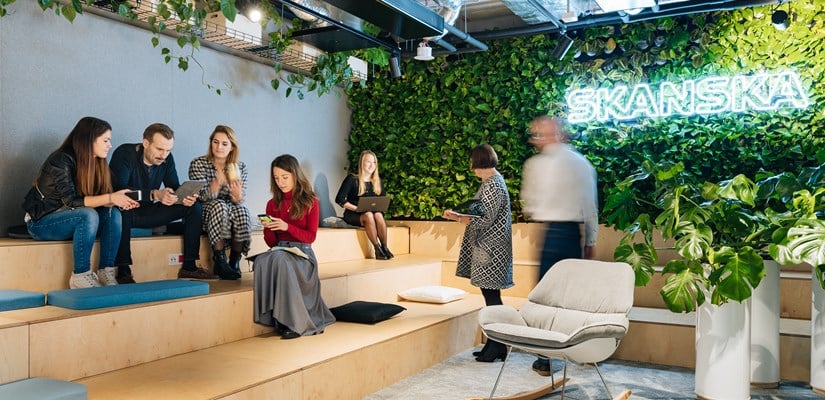
The Skanska office company and infuture.institute have once again undertaken to define trends related to office spaces of today and the future. The first joint project was the report "Living buildings. Office buildings of the future” showing what the future of office buildings will look like. It included five different scenarios in the mid and long term. Now it's time to take a look at the interiors, to see how the office spaces themselves will change and what they will offer employees.
Work on "Future of Office Spaces" report involved a series of studies. Finally, six trends were defined based on desk and field research, trend hunting, as well as qualitative and quantitative research (including interviews with experts). They were defined on the basis of social, economic, technological, environmental and political factors, in accordance with the STEEP model.
The domestication of the workplace, human-centric, biophilic design, innovation, hybrid and flexible spaces, as well as locality, are the most important factors that will define the interiors of office spaces in the future.
- As a matter of fact, we spend many hours a day at work - in offices, to be exact. It comes as no surprise then that how we function in them and how we feel in them impacts our emotional welfare – says Natalia Hatalska, Trendwatcher, Founder and CEO of infuture.institute. I hope that the survey results – quantitative and qualitative – presented in this report will be inspirational for you in creating offices of the future. It is very essential that they are as friendly as possible for the modern generation, often described as Indoor Generation. The surveys indicate that 90% of our time is spent inside of buildings, also in office buildings. Our wellbeing, health, but also efficiency and energy at work will depend on how they are designed. The fact that the direction we are heading towards seems right spawns optimism - adds Hatalska.
- We design our offices to meet the current and future needs and expectations of people who work in these offices in terms of the next 5, 10 or 15 years. We want to know what types of interiors they will need and that's why we are collaborating on this report. It can be an inspiration and support for both employers - our clients, as well as employees who are looking for an ideal office space, and perhaps an employer who will provide such as space for them, says Anna Tryfon-Bojarska, Innovation Manager at Skanska office company.
Technology, ecology, human-centric offices - what will be important for us in the workplace:
"Office As a Third Space" is the first trend that will be affected by social changes. It is also referred to as "domesticated space" or defined as "third space". It is an interior that incorporates both the personal space in your own home and a formal workplace that is the company's hallmark. A strong emphasis is placed on the interior design and atmosphere, including through accessories, comfortable armchairs and couches - similar to those we have at home, thanks to which the line between work and home is somewhat blurred.
An office space designed with solutions that improve psychophysical well-being is something more and more often expected by employees. The "Human-Centric Office" is a trend shaped by socio-environmental factors. It includes both design solutions and additional spaces in which employees can relax and unwind, including well-planned and designed workplace ergonomics. Other important factors in the office space include lighting, temperature, colours and acoustics, which affects the noise level in the office.
The "Deep Green Office" trend emerged out of a concern for the environment, ensuring sustainable development and vegetation in offices and around buildings. This is an environmental trend aimed at incorporating nature into the architectural design - inside and outside offices. This trend, however, is part of a broader perspective of looking at office space, as well as circular construction. It has brought a solution to the problem of wasting raw materials and increasing environmental pollution. Studies show that the presence of plants in the workplace lowers anxiety and improves well-being. It also affects our health directly. Thanks to the presence of plants, employees are more resistant to stress - they have lower cortisol levels, lower heart rate and blood pressure, and a better immune response. In addition, plants help improve creativity and focus.
The "Seamlessly Connected Office" is a trend in which the primary task of technology is to solve people's problems (sometimes even before they appear), bring them together in the workplace, optimise their efficiency, and increase their comfort and well-being in line with the Human First trend. Office spaces are places where intelligent technologies (such as those based on AI, IoT, VR, AR, beacons or biometrics), platforms or applications facilitate work and office operations.
Currently, hybrid spaces and offices are becoming more and more important, as they can combine various types of work and employees, companies or areas of professional activity. The "Hybrid Workstyle Spaces" trend was created on the basis of economic changes, where independent entrepreneurs, freelancers, start-ups and large corporations can work side-by-side in offices, which makes it easier for them to establish cooperation. Office spaces are easily adaptable and flexible, with plenty of open spaces, multifunctional meeting places and mobile furniture.
The last trend mentioned in the report is "Neighbourhood-Bound Spaces". Excessive digitisation and access to the Internet, quickly transitioning between reality and the virtual world, can cause a loss of identity and feeling of belonging to a specific place. The report shows that creating a space that is synonymous with locality, a known and recognised space, will become more significant. Offices and office buildings are increasingly becoming inscribed in the local context. When it comes to office spaces, architecture and design become a means of expressing the local specificity of the place. This way, offices focused on the concept of locality present themselves as engaged companies that are part of the surrounding area.
Download the report: http://infuture.institute/future-of-office-space/